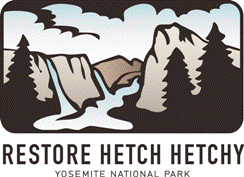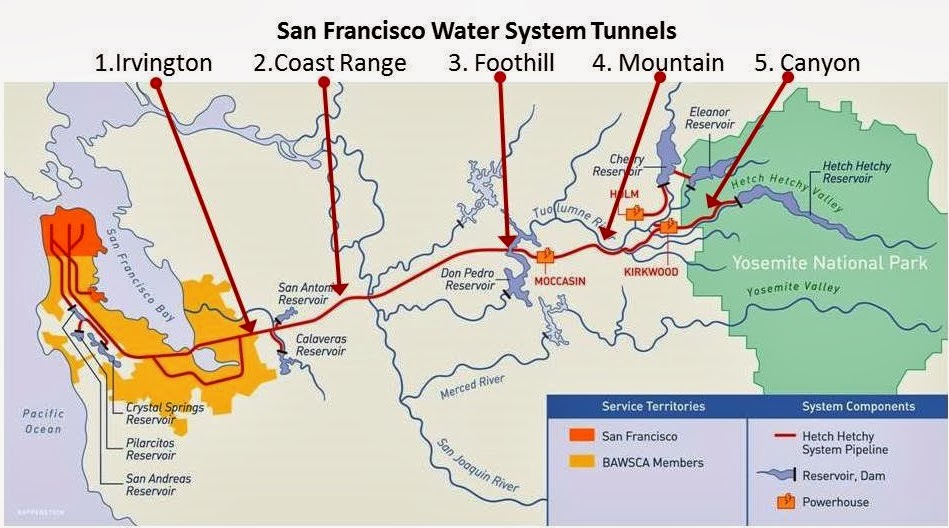Wednesday, February 26, 2014
Sunday, February 9, 2014
Day hikes into the Grand Canyon of the Tuolumne?
Friday, January 17, 2014
Can the drought provide a silver lining for Yosemite’s Hetch Hetchy?
The Governor’s executive order does do a few things. It includes provisions to streamline (pun intended) water transfers - the market-based sale of water from one user to another. Transfers can be complicated, physically and politically, but when done right transfers provide a powerful economic incentive for efficient use while reducing the pressure to increase diversions from our rivers, streams and wetlands. But the appropriate processing of and guidelines for managing water transfers should be in place permanently, as executing them on a piecemeal basis in dry years serves neither the planning needs of water agencies nor the public’s need to ensure natural resources are not harmed.
Friday, December 20, 2013
Media Summary of Raker Act Centennial
See below for a summary of media coverage of the centennial of the Raker Act on December 19, 2013. The Raker Act was the legislation that allowed the damming of Yosemite’s Hetch Hetchy Valley.Happy Holidays,
Spreck
o Viewpoints: Time to
return Yosemite’s Hetch Hetchy to the American people, Spreck Rosekrans, Sacramento Bee, 10-20-13
o Restore Hetch Hetchy? In can be done, Dan Lundgren and John Van de Kamp, Los Angeles times, 12-2-13
o Hetch Hetchy: Congress should undo the destructive
Raker Act, Bob Binniweis, B.J. Griffin and Dave Mihalic,
San Jose Mercury News, 12-13-19
Blogs etc.
o Restoring the Lovely Hetch Hetchy Valley Restores
More Than A National Park, Prof. Barbara Mossberg,
Huffington Post, 12-17-13
o Hetch Hetchy and a
Century of Environmentalism, Roger Williams, Sierra Club, 12-18-13
o Hetch Hetchy: A century of occupation in
Yosemite National Park, Spreck Rosekrans, Mavens Notebook: A water,
science and policy blog, 12-19-13
o A Vision for Restoring Yosemite’s Hetch Hetchy Valley, Ken Brower, Earth
Island Journal, 12-19-13
o Gathering the spirit to recover the river wild, Letters, San Gabriel Valley Tribune, 12-19-13
o An Unhappy Anniversary for Hetch Hetchy, Rick Frank, Legal Planet, 12-20-13
o 100 years later, SF water war rages on
–Hetch-Hetchy or Bust!!,
Stephen Frank, California’s Political News and Views, 12-19-13
o Hetch Hetchy—San Frans’ Water and Budget Balancer, Stephen Frank, California’s
Political News and Views, 9-18-13
Wednesday, December 18, 2013
Wednesday, December 21, 2011
Fact vs. Fiction: Restoration Of Hetch Hetchy Valley in Yosemite National Park
Fact vs. Fiction: Restoration Of Hetch Hetchy Valley in Yosemite National Park
It was great to hear Mike Marshall, Restore Hetch Hetchy Executive Director, and Congressman Dan Lungren on KQED radio today discussing the opportunity to restore Yosemite National Park’s second great valley with host Michael Krasny.
The show is posted on KQED’s website and is definitely worth a listen: http://www.kqed.org/a/forum/R201112210900
Ed Harrington, general manager of the San Francisco Public Utilities Commission, and Jim Wunderman, president and CEO of Bay Area Council, presented the opposing view that the reservoir should be left in place. These men raised a number of valid issues that must be addressed.
But Wunderman and Harrington also misrepresented a number of fundamental facts about the existing system and what restoration would involve. These misrepresentations include:
Fiction: All 400 MW of San Francisco’s hydroelectric power would be destroyed.
Fact: The truth is that all three of San Francisco’s hydroelectric power plants would still be operational and only the Kirkwood plant would generate significantly less power during late summer and fall when the Tuolumne River’s natural flow is low. Modeling studies suggest only 20% of San Francisco’s hydropower would be lost, certainly not all of it.
Fiction: San Francisco and its customers have just invested 4 billion dollars in this system to make it seismically safe and this money would be wasted if restoration takes place.
Fact: This investment pertains to retrofits in the Bay Area that have little to do with the water that San Francisco stores in the Sierra Nevada. Restore Hetch Hetchy has supported the retrofit and encouraged other environmental groups to do so as well. This is money well spent but is a separate issue from restoration.
Fiction: The California Department of Water Resources said restoration would cost 10 billion dollars.
Fact: DWR actually said it could cost as little as 3 billion dollars or as much as 10 billion dollars. And even the lower estimate of 3 billion dollars included enough additional water supply to replace the relatively small amount that would be lost several times over.
Fiction: Restoration would put the region at risk in huge ways.
No one has proposed that restoration of the valley take place until facilities to provide equivalent water and power to those who use it are in place and operational.
Fiction: The Bay Area would go to the bottom of the list in terms of water rights.
Fact: Restoration would not affect anyone’s water rights to the Tuolumne River. All it means is that the water would not be stored in Yosemite National park.
Fiction: The Bay Area would not have sufficient water in 1 out of 5 years.
Fact: In one out of five years some water would need to be replaced. In most years, San Francisco’s other 8 reservoirs and water rights on the Tuolumne would provide full supplies while allowing ample reserves.
Fiction: 85 % of San Francisco’s water is stored in Hetch Hetchy Reservoir.
Fact: Hetch Hetchy Reservoir stores only about 25% of San Francisco’s water.
Fiction: It would take a huge amount of energy to pump the water to San Francisco if Hetch Hetchy Valley were restored.
Fact: Water would still be diverted at “Early Intake”, on the Tuolumne River just below Yosemite National Park, and would flow from there to the Bay Area under gravity. Very small amounts of energy would be required in some parts of the system, as it is now.
Fiction: Hetch Hetchy Reservoir was required because San Francisco ran out of water to fight the fire following the 1906 earthquake in San Francisco.
Fact: San Francisco had plenty of supply in local reservoirs in 1906. The problem was that pipes within the city broke during the quake.
Fiction: Restoration would bring tremendous risk and harm to the region.
Fact: The amount of water and power at stake are not large, but are far less than has been replaced in other environmental restoration projects around the State. And restoration will not take place until replacement facilities are in place.
Restore Hetch Hetchy understands and respects that many people have other priorities and do not support restoration. We believe, however, that the debate over restoring Hetch Hetchy Valley in Yosemite National Park is worth having. And we ask our opponents to stick to the facts.
Interested persons can learn more about these issues by reading the plethora of reports posted at http://www.hetchhetchy.org/resources.
Monday, August 8, 2011
Big Lil Loop, Day Two
Sublime is how I’d describe Day 2 of our adventure. After a restful night we woke to a breakfast of grits with cheese and sun-dried tomatoes. I was feeling wonderful. Most of the group was planning a hike around the lake to see the view from a dome on the side of the lake. I definitely did not want to tax myself with that, but I did want to walk back a mile to Beehive and see all the flowers during the day. Unfortunately everyone except Rebecca, Jason’s 11-year-old, was going on the long hike and Rebecca wanted to stay in camp. Heather advised me against going alone, and I happily obliged.
Instead, I sat in the shade and wrote in my journal. I laid on my back and meditated on the tree tops. I read from a book of Muir writings borrowed from Mike Marshall. And a few times I made the 20-foot trip over to the waters edge to sit on a log and filter water with electric-blue damselflies sailing about in between their own log rests.

Close to lunch time the group returned with tales of climbing across fallen logs through marshy fields. We had a lot lunch of leftover rice and beans, at my suggestion (that food had not sounded tasty the night before, but did now; a good sign.)
It was 2 p.m. by the time we packed up and headed down the trail, but we only had four mostly-downhill and shaded miles to go to our next and last camp, Gravel Pit Lake. Just as we started out and crossed a stream that fed into Laurel Lake, we came out of the trees into a picture-perfect meadow decorated with flowers and butterflies. Clouds formed behind us to the north that could have held lightning, and later we did think we were hearing a bit of thunder.
Heather had us gather ‘round and gave us a writing assignment (I was thrilled)! She asked us to think about something we had seen and write about it in the flowery way of Muir. My mind began working immediately.
On we ventured to the tune of conversation that ranged from music to religion to SF politics. At Gravel Pit Lake, we were quickly attacked by mosquitos, but found refuge a bit uphill in our own rock city, with established fire rings and knock-out views atop house-sized boulders.











